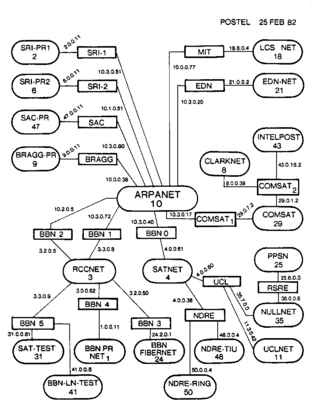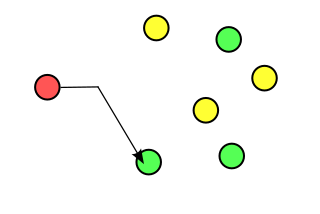The Dynamic Host Configuration Protocol (DHCP) is a network management protocol used on Internet Protocol (IP) networks for automatically assigning IP addresses and other communication parameters to devices connected to the network using a client–server architecture.
An Internet Protocol address is a numerical label such as 192.0.2.1 that is assigned to a device connected to a computer network that uses the Internet Protocol for communication. IP addresses serve two main functions: network interface identification, and location addressing.

Internet Protocol version 4 (IPv4) is the fourth version of the Internet Protocol (IP). It is one of the core protocols of standards-based internetworking methods in the Internet and other packet-switched networks. IPv4 was the first version deployed for production on SATNET in 1982 and on the ARPANET in January 1983. It is still used to route most Internet traffic today, even with the ongoing deployment of Internet Protocol version 6 (IPv6), its successor.

Internet Protocol version 6 (IPv6) is the most recent version of the Internet Protocol (IP), the communications protocol that provides an identification and location system for computers on networks and routes traffic across the Internet. IPv6 was developed by the Internet Engineering Task Force (IETF) to deal with the long-anticipated problem of IPv4 address exhaustion, and was intended to replace IPv4. In December 1998, IPv6 became a Draft Standard for the IETF, which subsequently ratified it as an Internet Standard on 14 July 2017.
Classless Inter-Domain Routing is a method for allocating IP addresses for IP routing. The Internet Engineering Task Force introduced CIDR in 1993 to replace the previous classful network addressing architecture on the Internet. Its goal was to slow the growth of routing tables on routers across the Internet, and to help slow the rapid exhaustion of IPv4 addresses.
A multicast address is a logical identifier for a group of hosts in a computer network that are available to process datagrams or frames intended to be multicast for a designated network service. Multicast addressing can be used in the link layer, such as Ethernet multicast, and at the internet layer for Internet Protocol Version 4 (IPv4) or Version 6 (IPv6) multicast.

A subnetwork, or subnet, is a logical subdivision of an IP network. The practice of dividing a network into two or more networks is called subnetting.

A classful network is an obsolete network addressing architecture used in the Internet from 1981 until the introduction of Classless Inter-Domain Routing (CIDR) in 1993. The method divides the IP address space for Internet Protocol version 4 (IPv4) into five address classes based on the leading four address bits. Classes A, B, and C provide unicast addresses for networks of three different network sizes. Class D is for multicast networking and the class E address range is reserved for future or experimental purposes.
Bogon filtering is the practice of filtering bogons, which are bogus (fake) IP addresses of a computer network. Bogons include IP packets on the public Internet that contain addresses that are not in any range allocated or delegated by the Internet Assigned Numbers Authority (IANA) or a delegated regional Internet registry (RIR) and allowed for public Internet use. The areas of unallocated address space are called the bogon space.
Zero-configuration networking (zeroconf) is a set of technologies that automatically creates a usable computer network based on the Internet Protocol Suite (TCP/IP) when computers or network peripherals are interconnected. It does not require manual operator intervention or special configuration servers. Without zeroconf, a network administrator must set up network services, such as Dynamic Host Configuration Protocol (DHCP) and Domain Name System (DNS), or configure each computer's network settings manually.

Anycast is a network addressing and routing methodology in which a single IP address is shared by devices in multiple locations. Routers direct packets addressed to this destination to the location nearest the sender, using their normal decision-making algorithms, typically the lowest number of BGP network hops. Anycast routing is widely used by content delivery networks such as web and name servers, to bring their content closer to end users.
A Martian packet is an IP packet seen on the public Internet that contains a source or destination address that is reserved for special use by the Internet Assigned Numbers Authority (IANA) as defined in RFC 1812, Appendix B Glossary. On the public Internet, such a packet either has a spoofed source address, and it cannot actually originate as claimed, or the packet cannot be delivered. The requirement to filter these packets is found in RFC 1812, Section 5.3.7.
In computer networking, localhost is a hostname that refers to the current computer used to access it. The name localhost is reserved for loopback purposes. It is used to access the network services that are running on the host via the loopback network interface. Using the loopback interface bypasses any local network interface hardware.
In Internet networking, a private network is a computer network that uses a private address space of IP addresses. These addresses are commonly used for local area networks (LANs) in residential, office, and enterprise environments. Both the IPv4 and the IPv6 specifications define private IP address ranges.
The Neighbor Discovery Protocol (NDP), or simply Neighbor Discovery (ND), is a protocol of the Internet protocol suite used with Internet Protocol Version 6 (IPv6). It operates at the internet layer of the Internet model, and is responsible for gathering various information required for network communication, including the configuration of local connections and the domain name servers and gateways.
The Dynamic Host Configuration Protocol version 6 (DHCPv6) is a network protocol for configuring Internet Protocol version 6 (IPv6) hosts with IP addresses, IP prefixes, default route, local segment MTU, and other configuration data required to operate in an IPv6 network. It is not just the IPv6 equivalent of the Dynamic Host Configuration Protocol for IPv4.
In the Internet addressing architecture, the Internet Engineering Task Force (IETF) and the Internet Assigned Numbers Authority (IANA) have reserved various Internet Protocol (IP) addresses for special purposes.
An IPv6 transition mechanism is a technology that facilitates the transitioning of the Internet from the Internet Protocol version 4 (IPv4) infrastructure in use since 1983 to the successor addressing and routing system of Internet Protocol Version 6 (IPv6). As IPv4 and IPv6 networks are not directly interoperable, transition technologies are designed to permit hosts on either network type to communicate with any other host.
A unique local address (ULA) is an Internet Protocol version 6 (IPv6) address in the address range fc00::/7. These addresses are non-globally reachable. For this reason, ULAs are somewhat analogous to IPv4 private network addressing, but with significant differences. Unique local addresses may be used freely, without centralized registration, inside a single site or organization or spanning a limited number of sites or organizations.

An Internet Protocol Version 6 address is a numeric label that is used to identify and locate a network interface of a computer or a network node participating in a computer network using IPv6. IP addresses are included in the packet header to indicate the source and the destination of each packet. The IP address of the destination is used to make decisions about routing IP packets to other networks.






